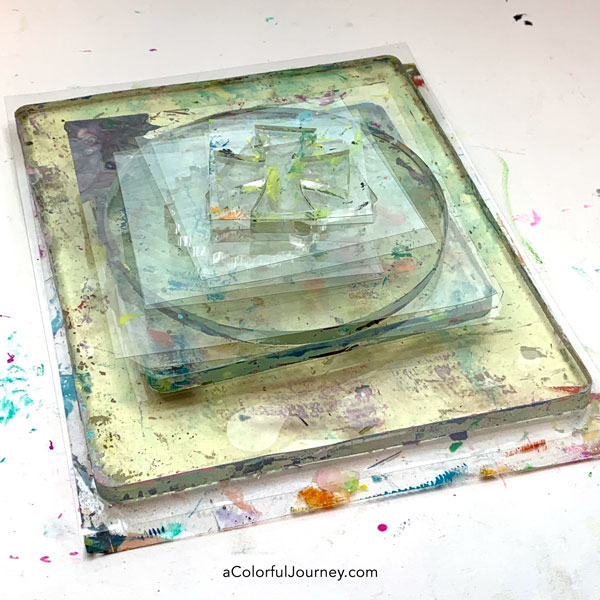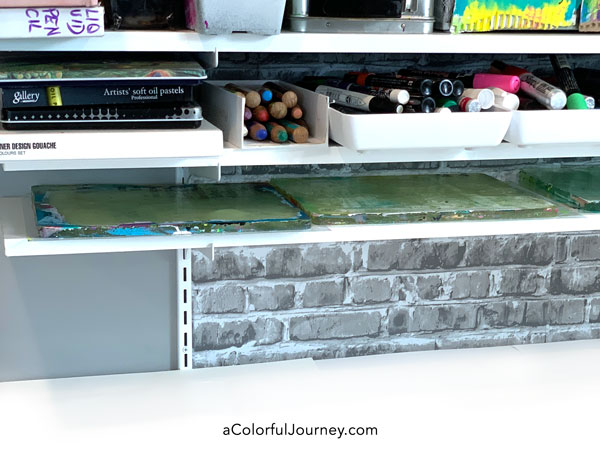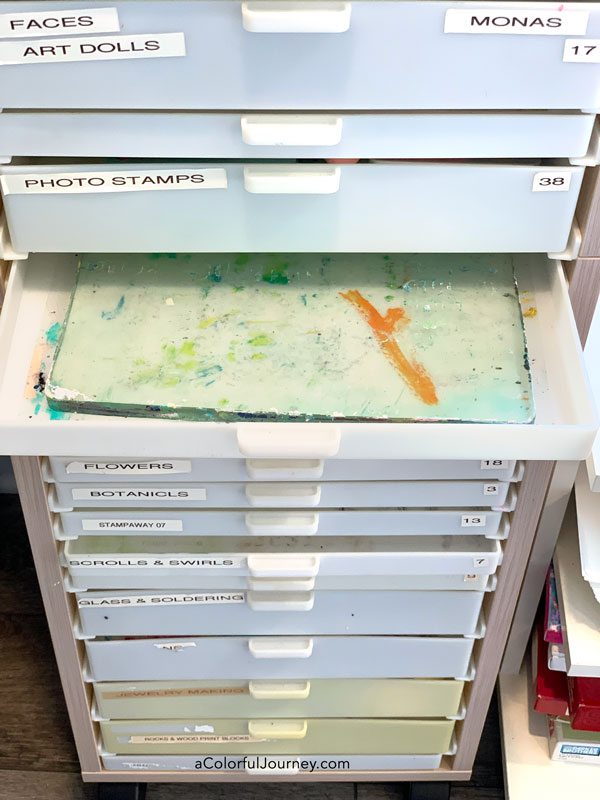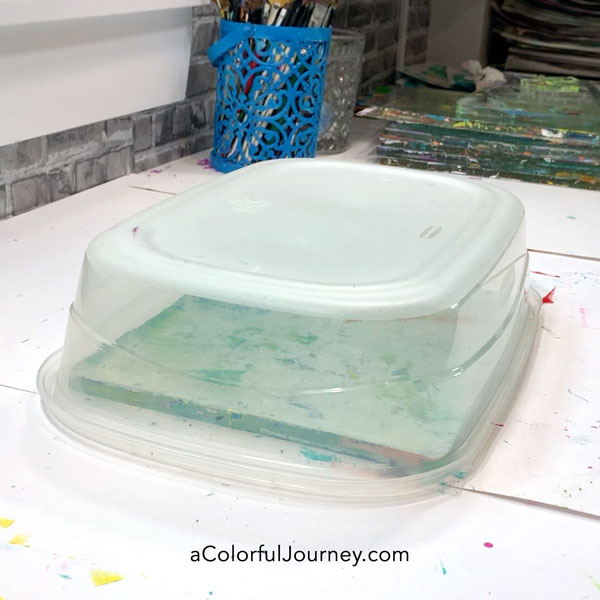What’s the right way to store your gel plate? You’ve probably heard conflicting ways to store them from different people. The reason for that is there is more than one way to do it. Keep reading to find out the reasons behind storing your plate, because when you understand why something happens it is so much easier for you to confidently choose the way that fits you best.

To figure out the best way for you to store your gel plate, you’re going to need know something about you (that’s easy, you probably know you pretty well) and about gel plates. What I’m sharing here is for any gel plate that has squish, like a Gel Press plate. After all, that is the big factor that lets a plate do its magic.
So let’s talk about you.
What type of creative are you? Do you like everything you own to look factory new even after years of use? Do you let your art supplies get covered in paint and they stay that way? Or are you somewhere in between?
How much space do you have? If you have a studio larger than an Amazon warehouse you have a lot more options than someone who has a just part of closet to store their supplies.
Now let’s dive into gel plates.
There are only 2 things that I avoid at all costs when storing my gel plates. First, I avoid anything that is absorbent that causes the mineral oil in the plate to leach out. So that means papers, or anything that when left on a gel plate for an extended period of time creates an oil spot. That’s why I love using the plastic protectors that come with the plates or cheap copier transparency sheets. Be sure to use ones that have no coating on them.

Second, I avoid storing them in weird or drooping positions. So no hanging halfway off the shelf kind of a thing or resting at an angle. I store mine either horizontally or vertically so that the plate will hold its shape.
One of the benefits of stacking gel plates is it lets me have them all within arm’s reach. Any time I stack gel plates I tend to store them horizontally. When stacking plates that are different sizes, I keep the plastic on both sides of all the gel plates and stack them in size order, with the largest on the bottom.
Anything that is trapped for a while between the gel plate and the plastic can leave an indentation in the plate. Air bubbles can leave indentations, a strand of hair, or anything else that gets in there. Those little indentations don’t impact my prints the way I print so I don’t worry about them. But that’s me and what’s important is that you store your gel plates in the way that fits your needs the best.
But how can you store your gel plates if you want to avoid those?
If you store it between the plastic sheets, put the plastic on carefully and brayer out any of the air bubbles. Another option is to store them with nothing on top such as on a shelf or in a drawer.


Since I use my plates all the time, there is never any dust build up on them when I store them on a shelf. If you only use your gel plate infrequently, you may find that dust accumulates on them when left uncovered, so having a cover of some kind over it may be helpful.

The bottom line is storing a gel plate is about it keeping its shape and storing it away from the things that will draw the oil out of the plate. There isn’t one single way to do this so you have the freedom to choose the way that fits you best.
Now that you know what to look out for when storing your gel plate, you can look at your stash and storage options to choose the answer that is best for you.
If you’ve found that understanding why is helpful, check out my gel printing workshops, because they are all about understanding why so that you can get the most out of your gel plate.


I think I threw my plastic pieces away! Any good substitutes that you could recommend? I like the idea you mention of keeping the one on the back. Thanks so much for this video. I immediately went and peeled off the paper that mine was wrapped in! There are others saying paper around the plate is better. But you are right, it is leeching out those oils.
I will use copier transparency sheets – the kind with no coating on them- as a non-absorbent surface Joan.
I contacted one of the manufacturers after I had been storing mine with the plastic sheets that came with it. Unfortunately my 8×10 Gelli plate had sustained bubbles / indentations that did affect print quality. I was advised to use paper on top instead of the plastic. Gratefully, I was able to get the indentations out by stacking very heavy books on top for a few days. And I keep a bottle of mineral oil on hand to recondition the plate.
Thank you so much for all your good ideas Thanks for telling us how to take care of our gel plates
One of my small gel plates feels soggy; and like it might tear apart . I’ve always stored it flat and in the plastic clamshell it came in. Don’t remember What brand it is. All my others are fine. Any suggestions? Thanks!
I’ve never experienced a soggy gel plate Elaina. It sounds like you did everything right in terms of storage- so if you can remember the manufacturer, I would reach out to them.
I love seeing/reading about storage and art/craft rooms and would love a video that’s specific about your types of storage – with links if they exist!
The Gelli Arts folks stack their plates with copy paper in between each one. At least they did a few years ago when it happened to come up in a phone conversation. The plastic sheets drove me crazy because they’d trap air and I’d get bubbles or lines. Now bubbles and lines are great, but I like to choose sometimes! So I leave them in their hard plastic holders with copy paper and they’re fine many years later. *But it may depend on the manufacturer.* Just found this from Gelli Arts: “We recommend storing your plate in the box it arrives in – and cover both sides with plain white copy paper. Make sure to remove any air pockets by smoothing out the paper as much as possible. Take care not to trap any debris or paint residue between the paper and gel plate.”
I keep my plates on the original plastic sheets in their clamshells – the first one I had was a Gelli plate and that was what they said to do…. the air bubbles are a pain but I gave up worrying about them! However, I recently got a 20×16 Gelli plate and it didn’t come with a clamshell (!!!) – it’s a bit of a floppy nightmare so I never remove the bottom plastic sheet, have to keep it in a very big drawer with its topsheet on and put thick cardboard above & below it to protect it!! Any ideas would be welcome if anyone’s found a better way to deal with the giant!!
No clamshell? Yikes! Sounds like you found a great solution using what you had on hand Elva!
Great information, Carolyn! I got a bunch of the Ranger tin storage boxes and have my plates sorted into those but I think I’m going to get rid of the plastic sheets as I’ve kept those for some of the plates and not others. When I’m printing I work on the nonstick craft sheet (bought it in larger size from Joggles) so the only contact with paper is the printing process itself. I never thought of standing them up and the tins make that an easier option than dealing with the pile of them but I wonder if they’ll “droop” within the tin since there’s space. Thanks again for a terrific video.
You’d have to experiment with the tins since I have never used one Donna. If the plate is without any plastic sheets, I would think it will stick solidly to the bottom of the tin. Hold it upright and see if it stays solidly stuck to the tin. If it does, then I would think that upright would not involve any drooping. But, this is just a guess since I haven’t used the tins. So investigate with what you have. Hope that helps!
What about butcher paper. Put the plate onside that the meat is put on? Just a thought – have not done that.
I would stay away from coated papers- the coating can stick to the plate Kathy.
Great tips Carolyn. I had no idea about the oils and paper. Now it makes sense🙏
Hi Carolyn,
can you recommend any other “squishy” gel plate? The one you recommend on this webpage amazon says currently unavailable on amazon. They don’t know when or if this item will be back in stock.,,
Thank you
Sarah
I don’t know what the computer elves are up to Sarah, when I click on it, I get a great big selection of Gel Press plates- all in stock and with Prime shipping. Perhaps it was just a glitch when you clicked on it? On the page, you can choose which size you are interested in https://amzn.to/3ddphlE
What great ideas! Thank you so much for sharing!
I was just teviewing yhis with a fellow GP addict. Thanks for the perfect timing.
Great tutorial, Carolyn. Thanks, for all the good informaion!
Carolyn, I recently got air bubbles in my gel plate. I have many and this is the first time it has happened. Gelli arts told me to clean it and place copy paper on top and bottom and add weight. It worked. When I took the paper off I did notice a residue on the paper. They say to store it with the paper. You say no and I think you are right. What are the plastic sheets and I will try to get new ones for it. Or do you have other advice. I love my gelli plates and you are the expert on them as far as I am concerned. Blessings, Jane James
that was great advice for how to store the jell Plates as have limited space in NY ..thank you for sharing your knowledge
I am new to Gelli printing and you have answered all my questions about plate care and storage. Thank you!
But that’s counter to what the manufacturer advise! Don’t use the plastic covers they come with because they create pockets of air you can’t get out unless you spend a lot of time pushing out and if you do they create indentations. Sometimes this indentations are permanent. They say use paper to cover both sides of your plate as they make smooth contact and no pockets of air no indentations. I do keep handy baby oil to condition if I’ve had them stored for a while. 🤷🏻♀️
So I’m very very new to gelli printing. My question is when I’m using my plate, what should or shouldn’t I put underneath it…can I just put it on a peice of cardboard that I use to catch spray and splatters? Thank you!
It’s personal preference Roxanne. I prefer to leave the plastic on the bottom so that it doesn’t pick up all the bits and grunge on my counter. You can put it on paper or cardboard, just know that if you leave it on there for extended periods of time it will pull some of the mineral oil out of the plate.
I teach a beginners gel plate class at different locations. My 12 plates are 8×10. I would like to store each plate and brayer in it’s own container. Any ideas?
Great info thank you.